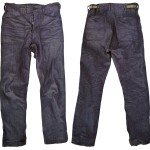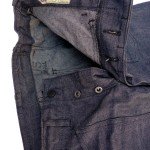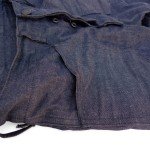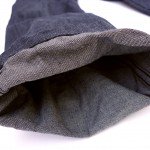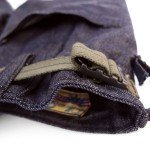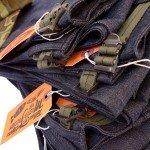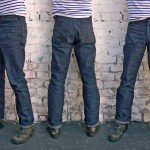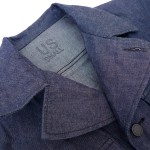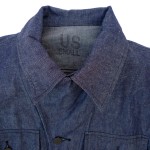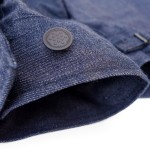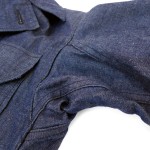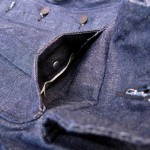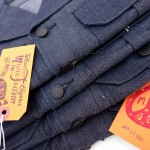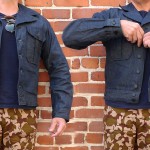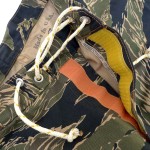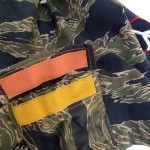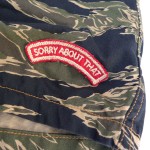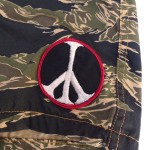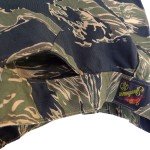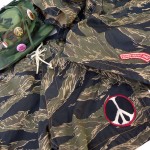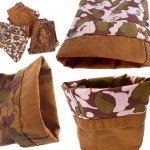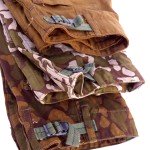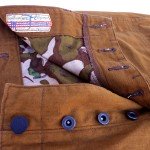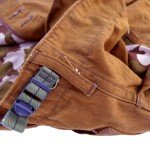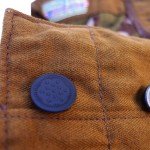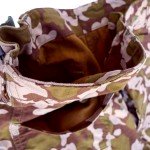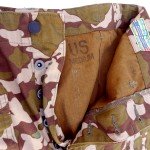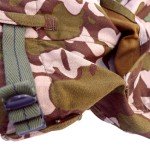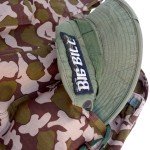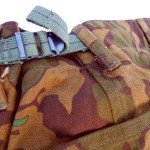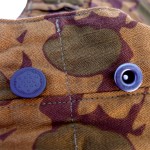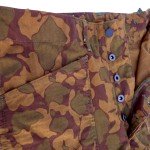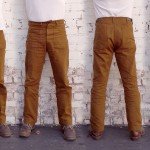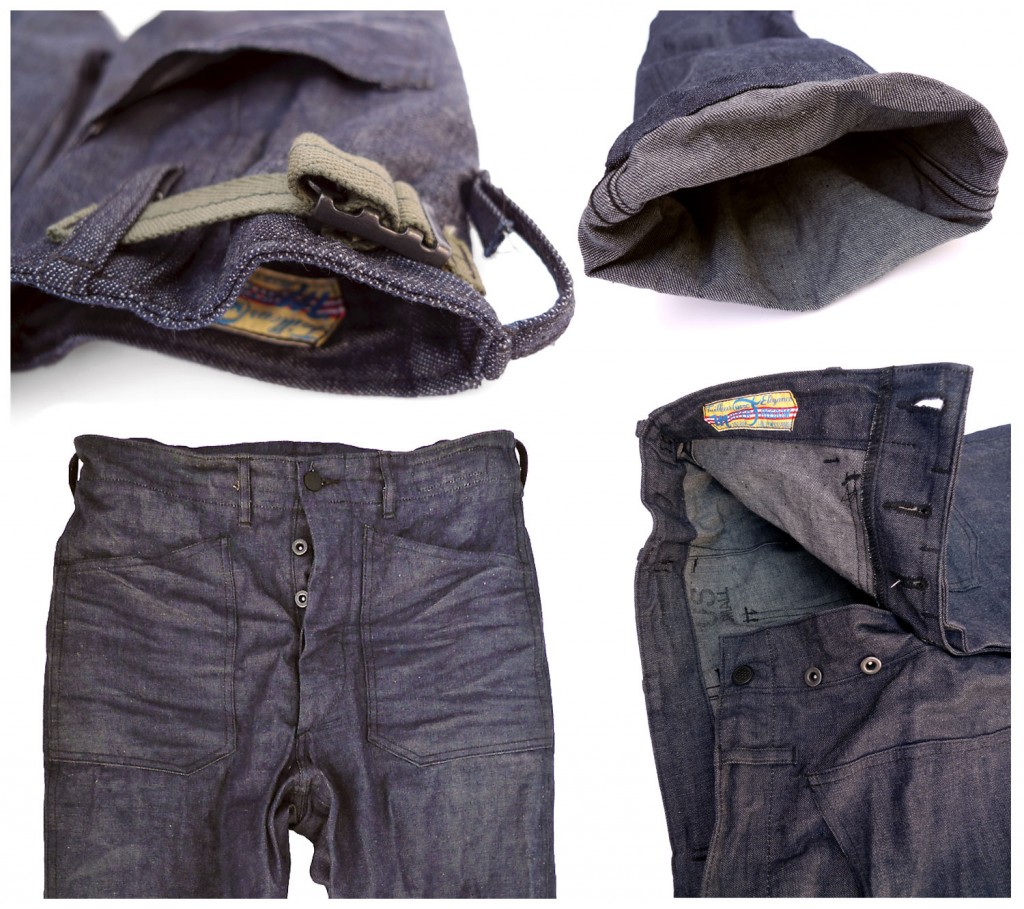
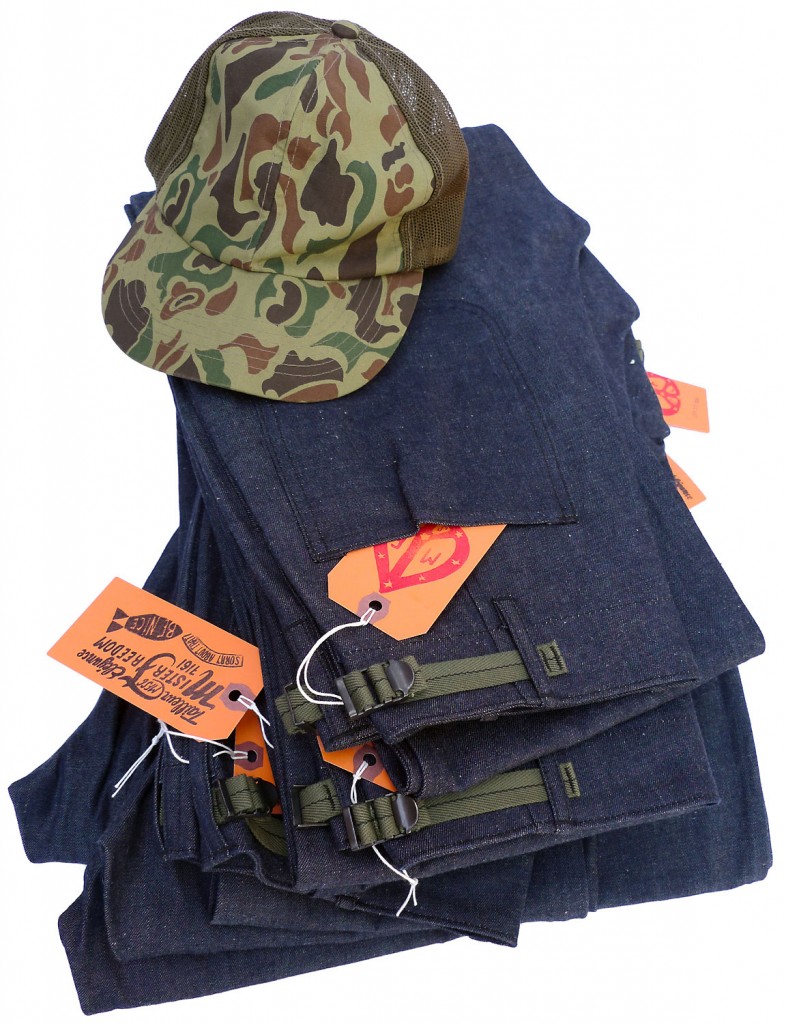 Redneck hat optional
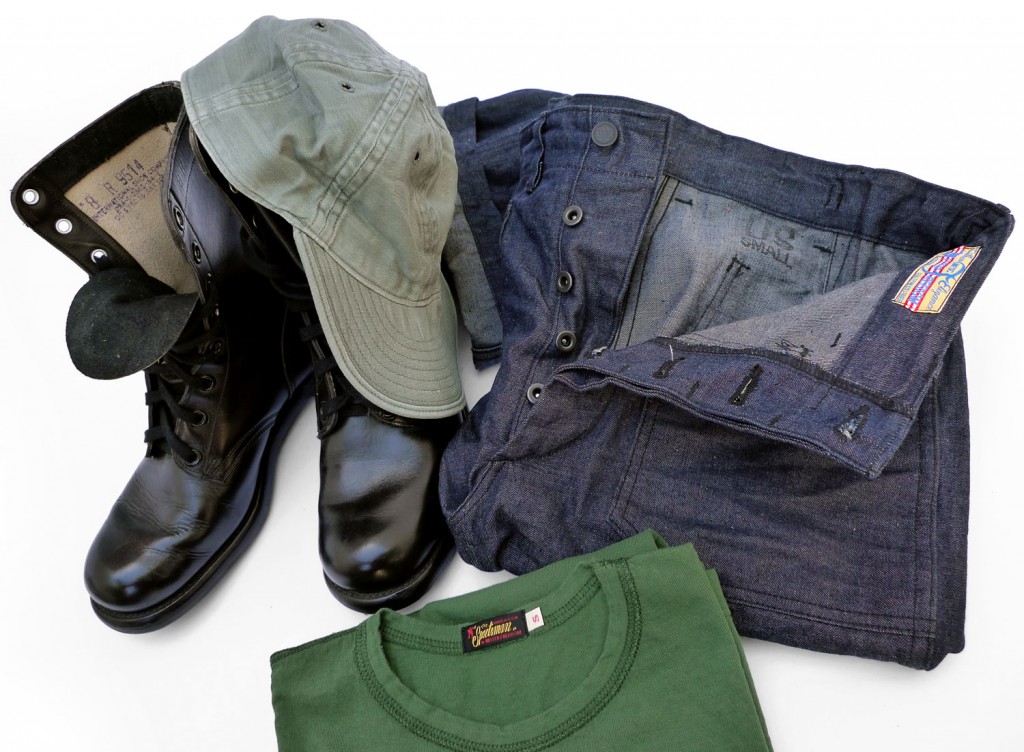
Utility Trousers, Denim
“Saigon Cowboy” mfsc spring 2015
utility
u·til·i·ty
yo͞oˈtilədē/
adjective
* functional rather than attractive.
Example: “utility clothing”
There is it.
We previously introduced the featured trousers of our Saigon Cowboy spring collection with their recent experimental camo release. The same pattern was used for this denim issue. The Utility Trousers, Denim borrow details from US Navy dungarees (CONTRACT DA-30-352TAP-2031 to be precise), Army chino trousers, M-51 field trousers, Marine Corps M1941 trousers… all blended in the MF® shaker.
The fabric is that of the Utility Jacket, Denim, inspired by the lightweight 2×1 denim of original 40’s-50’s US Army barrack bags.
Expertly milled in Japan based on a vintage US Army un-issued barrack bag from 1951, our new 10 Oz. indigo-dyed selvedge denim features a slight nep (woven ‘imperfections’ in the form of tiny whitish cotton balls), with the stiff-dry-crispy feel of NOS denim.
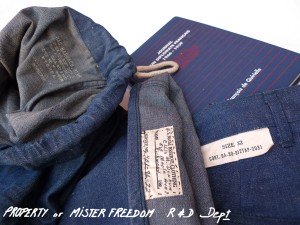 Blue inspiration As a work-type garment not having to rank high in attractiveness, our Utility Trousers are quite inconspicuous, in and out. And, do mark your calendars, we went as far as not show the selvedge anywhere. Refreshing, isn’t it. For the selvedge galore, and a tantalizing KP duty tuxedo, check out the trousers’ matching top.
To complete the unassuming appearance, our utes feature black-painted ‘burst of Glory’ type metal buttons, black oxidized donut fly buttons, and black color cotton thread tonal stitching.
The specific sizing S,M,L,XL applied to trousers could sound odd, but is a nod to old military field pants featuring cinch tabs. Those are often tagged with a ‘size range’ as opposed to a precise measurement, reflecting the waist-adjusting pull tabs.
The “US” stamp stands for sizing following American standards, as opposed to the “A” stamp differentiating Asian standards garments with CISO-issued gear.
Along with our Evac Jak and Utility Jacket, Denim these Utility Trousers, Denim are extrapolations of historical events we are briefly evoking as we unfold this Saigon Cowboy collection. Some will be familiar with these pages of History, some will wonder why on Earth we’re turning them, some will enjoy learning tidbits, some will want to burn the book, some will zip to the washing instructions…
I personally consider the Past to be valuable forewarning material, rather than mere dust for under the rug. You don’t agree or not with factual History, you are either aware of it and learning a lesson, or ignoring it and perpetrating more of the same. Most readers of this blog are probably too young to have either fought or protested the Vietnam war. Still, mentioning it in 2015 seems important food for thought to me. I won’t be sharing macabre combat photography that no one wants to look at, nor glamorize events either. I won’t even tell it like it is, because I was 10 when it ended and have no idea how it was. But enticing one to look things up with these brief posts will hopefully prove more useful than sharing self-coaching quotes on cutesy sunset photo backgrounds, or other such inspirational platitudes social media grace us with. History comes in handy in the voting booth.
“How are you tomorrow?”
Michael Herr, Dispatches (1977)
The Utility Trousers, Denim are designed in California by Mister Freedom® and manufactured in Japan by Sugar Cane Co.
FABRIC:
10 Oz. indigo-dyed 2×1 denim, solid white ID selvedge. Milled in Japan.
DETAILS:
* Inspired by vintage military utility trousers.
* Mid-high waisted.
* Front patch pockets locked in side seam, rear patch pockets, horizontal HBT.
* Side cinch tabs, mil-spec slide buckle.
* Flat black-painted Metal “13 Stars” tack waist button.
* Oxidized black donut-type fly buttons.
* Flat felled seams, chainstitch.
* 100% cotton tonal stitching.
* Made in Japan.
SIZING/FIT
This garment comes raw/unwashed and will shrink to tagged size after an original cold soak/line dry. Further shrinkage to be expected with the use of hot water and heat dryer.
I decided to size down in those, as I had done with the Crew Pants of the Sea Hunt spring 2013 collection, and I am wearing a Small (30). When both fully cinched, the waist tabs can tighten the fit by about 2 inches, but a Medium looked too baggy on me. A tagged Small technically corresponds to a 30-32 inch waist.
Please refer to sizing chart for measurements reflecting a 30mn cold soak no agitation/line dry.

CARE:
Launder when hygiene dictates and common sense prevails.
Machine wash. Cold water, gentle cycle, eco-friendly mild detergent and line dry. We recommend turning indigo blue/denim garments inside out to avoid marbling when washing.
Patina will develop according to activities and frequency of wear.
Available RAW/unwashed
SIZES:
X-Small (28)
Small (30)
Medium (32)
Large (34)
X-Large (36)
XX-Large (38)
RETAIL $329.95
Available from www.misterfreedom.com, fine retailers around the World, and our dusty Los Angeles brick & mortar store.
Email sales@misterfreedom.com or call 323-653-2014 with any questions unanswered above.
Thank you for reading and for your support
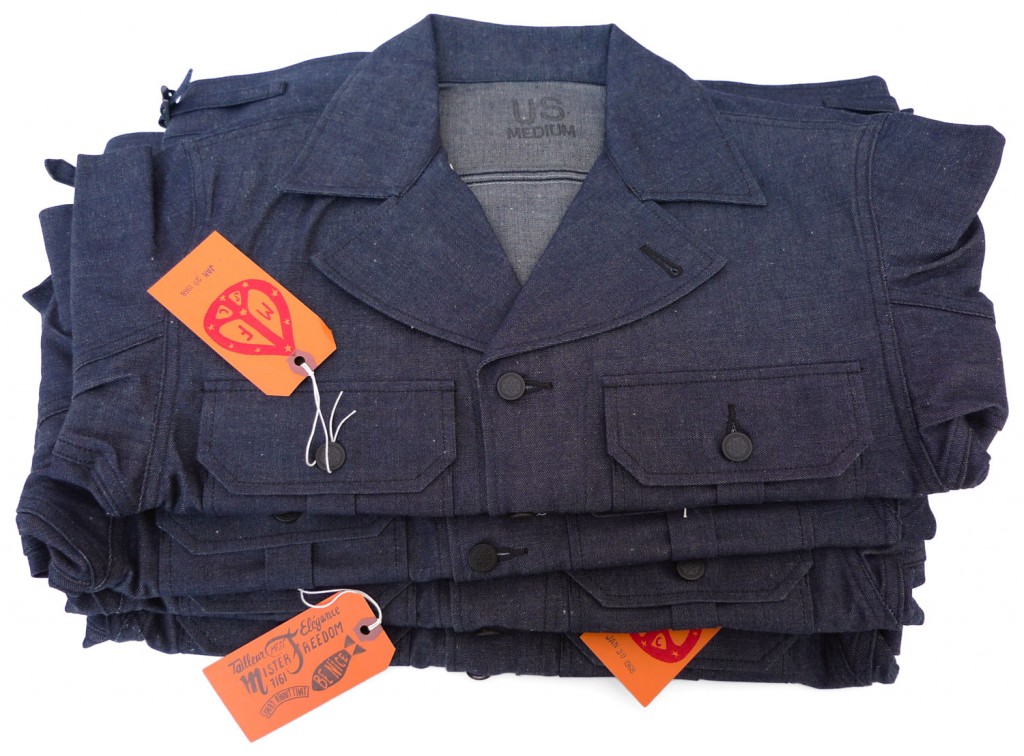

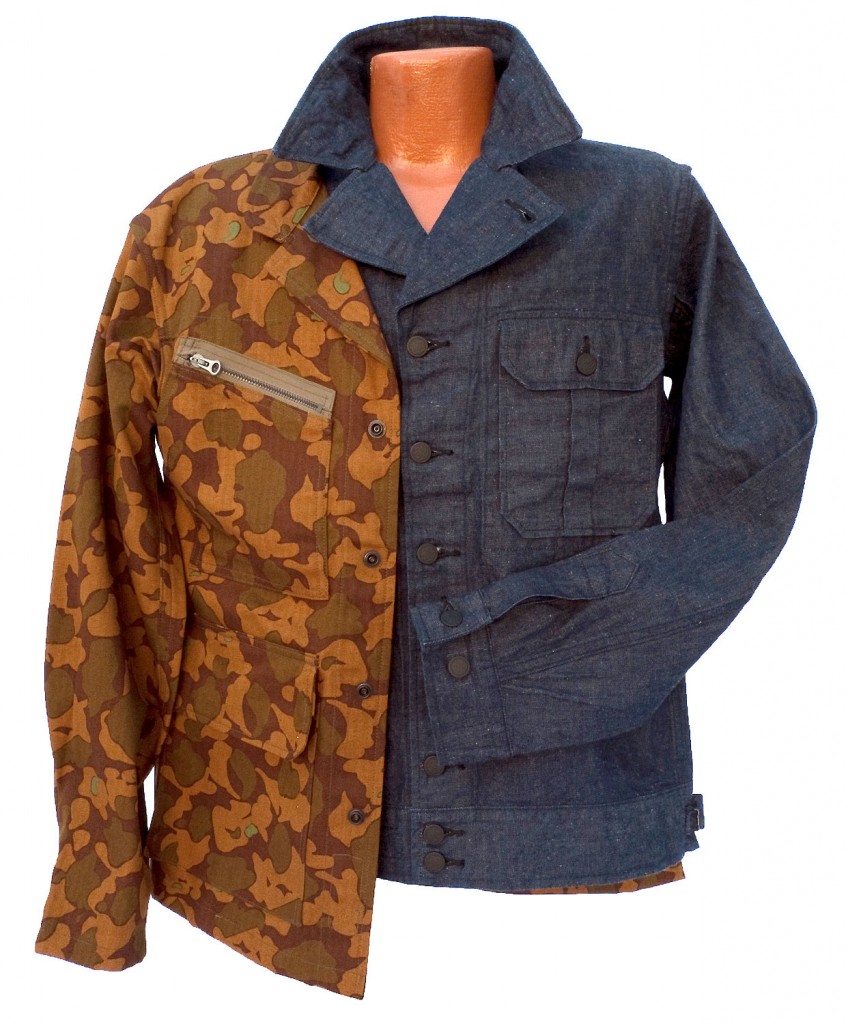
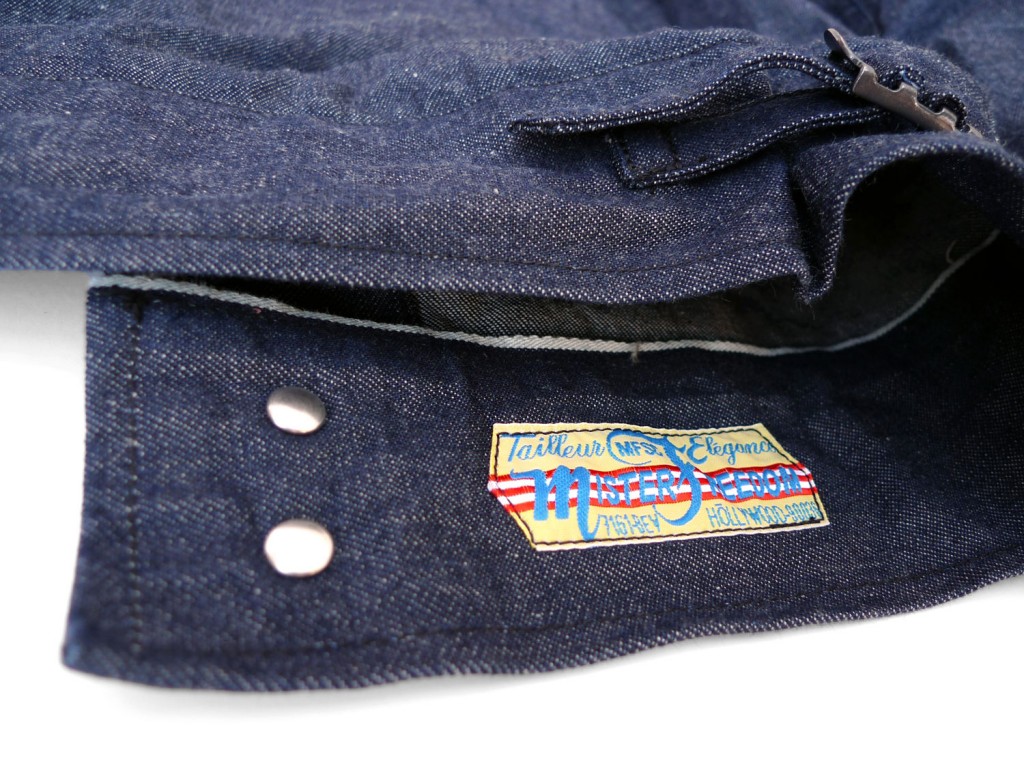
Utility Jacket, Denim.
“Saigon Cowboy” mfsc Spring 2015
I must fully credit the US Army for the design on this number. The overall pattern of the MF® ‘Utility Jacket, Denim‘ is lifted from a first issue HBT M1941 utility jacket. In 1941, this olive drab HBT short work jacket had replaced the blue denim work uniform. It appears the R&D labs had picked up a bit of influence from civvy work clothes with this specific GI garment, very much resembling a pair of mechanic coveralls chopped in half.
We pretty much stuck to the original pattern, but what we didn’t lift is the awkward oversized original army fit. Some of you who have tried on vintage ones will relate. The HBT M1941 jacket was to be worn as an outer protective layer while on chore duty, rendering it about as flattering as a pair of coveralls. Unless you’re Veronica Lake.
Speaking of curves, some of my favorite features on this jacket are the attractive lapel line curve, and the armpit gusset construction. I don’t often take photo of my armpits, but next time I do, I’m wearing this jacket.
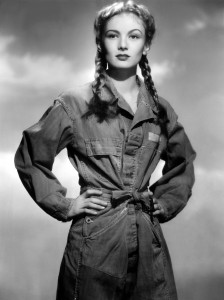 Veronica Lake in M1938 coveralls (1943) There is a well-documented mention in the “United States Marine Corps. Uniforms, Insignia and Personal Items of World War II” book (ISBN:0-7643-2264-8) of a custom theater-made USMC jacket based on that M1941 pattern, cut from a recycled frogskin shelter half:
” …some enterprising Seabee might have set up shop and sold/traded such camo sets to anyone who so wanted one, that is, as long as materials lasted!”
Such historical anecdotes (or plausible story in this case) tend to spark all kinds of ideas when designing clothes, which beats staring at what the other guys are doing for “inspiration“.
Now the fabric… If the Army went from blue denim to OD HBT as the cloth of choice for their utilities sometime in the late 1930’s, we figured we’d go back to denim for our jacket. I always had a thing for the lightweight 2×1 denim of the 40’s-50’s US Army barrack bags. Who doesn’t like those old stenciled WW2 beat up ones. Some 10 years ago, I was lucky to come across a stack of about 80, gathering dust in an old military surplus storage, outside Paris, France. Talk about custom markings inspiration.
Through our Sugar Cane Co friends, we managed to have some selvedge denim woven to the specs of an original un-issued bag part of that loot that we had kept in the archives. The Japanese mills did a great job. Spot on NOS military denim color face and reverse, slight nep (woven ‘imperfections’ in the form of tiny whitish cotton balls), stiff, dry and crispy. Perfect for our lightweight jacket.
-
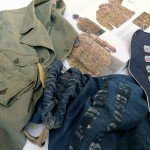
-
Well-worn vintage HBT M1941 MF® Archives ©2023
-
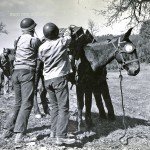
-
GI Mule Skinners (1944) Courtesy Sam Cox
-
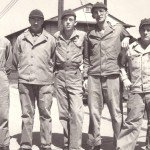
-
Eclectic US Army field jacket line-up (1943) (M1941 on right)
For the geographic requirement of our “Saigon Cowboy” collection, we took Mr. Glenn‘s Seabee bit from the Canal to the ‘Nam.
We had mentioned CISO declassified true story in a previous post, its logistics role in the Vietnam war and how custom gear was manufactured on Okinawa in the 1960’s to outfit US personnel en route to Vietnamese jungles or other across the fence places…
Our experimental camouflage Utility Trousers, the Evac Jak, and now the ‘Utility Jacket, Denim‘ are extrapolations of these pages of History, stretched out at will à la MF®. Nothing literal, just plausible fiction.
As a ‘work’ garment, our jacket looks quite subtle from the outside. We opted for black-painted ‘burst of Glory’ type metal buttons, black color cotton thread tonal stitching, and a skillfully orchestrated selvedge galore on the inside… That’s if you can take your eyes off the attractive armpits.
The “Utility Jacket, Denim” is (re)designed in California by Mister Freedom® and manufactured in Japan by Sugar Cane Co.
SPECS
FABRIC:
10 Oz. indigo-dyed 2×1 denim, solid white ID selvedge. Milled in Japan.
DETAILS:
* Revisited pattern of the US Army M1941 Utility jacket.
* Waist length.
* Side cinch straps, mil-specs metal sliders.
* Selvedge waistband, chest pocket fold and inner pocket.
* ‘Bat sleeve’ pattern with gusset for arm hole comfort.
* Expanding box pleat chest pockets.
* Inner chest pocket.
* ‘Burst of Glory’ type metal buttons, painted black.
* Adjustable cuffs.
* Chainstitch construction, black 100% cotton thread.
* mfsc ‘tailleur‘ woven label on the inside waistband.
* Made in Japan.
SIZING/FIT:
Our “Utility Jacket, Denim” comes raw/un-rinsed and will shrink to tagged size after a rinse/dry process.
We recommend an initial cold soak, spin dry and line dry.
I had to SIZE DOWN on this one, and opted for a SMALL, preferring the fit on me over a MEDIUM that looked too big.
Please refer to sizing chart for measurements reflecting a 30mn cold soak, no agitation, light machine dry.
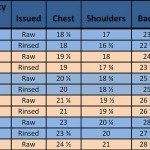
CARE:
Launder when hygiene dictates and common sense prevails.
Machine wash. Cold water, gentle cycle, eco-friendly mild detergent and line dry. We recommend turning indigo blue/denim garments inside out to avoid marbling when washing.
Patina will develop according to activities and frequency of wear.
Available RAW/unwashed
SIZES:
Small
Medium
Large
X-Large
XX-Large
RETAIL $369.95
Available from www.misterfreedom.com, our Los Angeles brick & mortar store, and fine retailers around the World.
Email sales@misterfreedom.com or call 323-653-2014 with any questions unanswered above, such as where does Sam Cox find all this stuff?
Thank you for your support 🙂
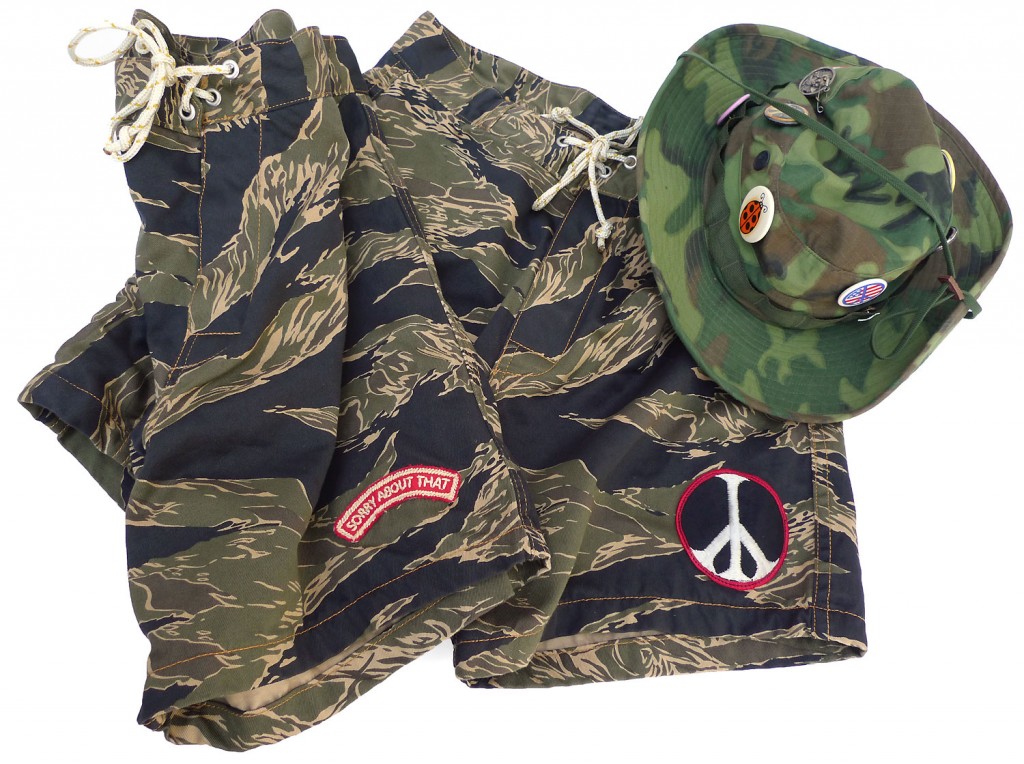

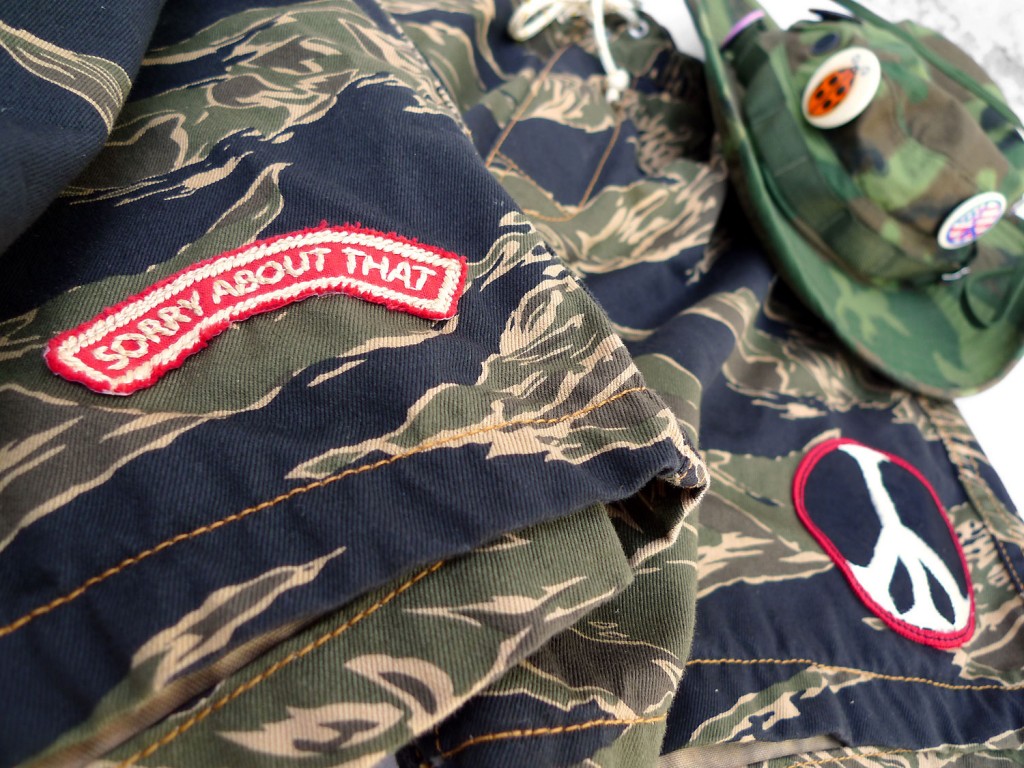
Tiger Board Shorts
“Saigon Cowboy” mfsc Spring 2015
“Mad Mark was the platoon leader, a first lieutenant and a Green Beret. (…) His attitude and manner were those of a CIA operative. A lover of stealth. A pro, a hired hand. (…) He wore tiger fatigues, not for their camouflage but for their look.”
Excerpt from ‘If I Die in a Combat Zone: Box Me Up and Ship Me Home’ Tim O’Brien (1975)
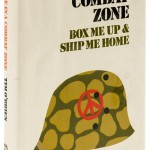 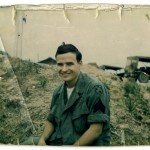
While Camp Pendleton Marines were chasing SoCal surfers out of Trestles, a few selected men of the Green Machine were board-riding the South China Sea waters of war-torn Vietnam. There it is.
Because eeeeverybody’s gone suuuurfin’, surfin’ USA in the 1960’s, the draft was to inevitably send some wave-obsessed kids to Vietnam. If Colonel Kilgore was a fictional character, several real life accounts testify of that. A certain Private Wyatt Miller Jr even managed to technically go MIA, last seen wiping out off Da Nang, on September 13, 1970…
Quite an interesting documentary, the 2008 film “Between The Lines: The True Story of Surfers and the Vietnam War” depicts the contrasting perspectives of combat vet surfer Pat Farley and surfer-dodger Brant Page, amongst others. Of hang tens and M-16s. Not a ton of period footage for obvious reasons, but insightful raw interviews nonetheless, not exactly highlighting the sanity of the Human race…
-

-
Marine confiscating board (1969) Photo Ron Stoner Courtesy SURFER
-
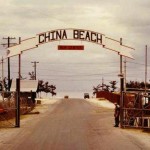
-
China Beach MP main gate
-
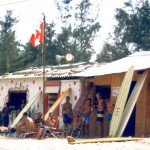
-
China Beach Surf Club, Vietnam, (1968) Photo Dennis Norton
-
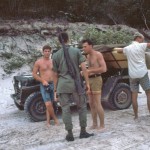
-
“Between The Lines”, Photo Greg Samp collection
-
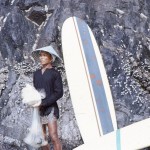
-
“Between The Lines”, Photo Tom Woods collection
-
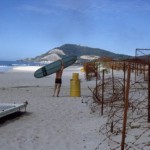
-
Vung Tau beach (1968) Photo Kerry Seebohm
-
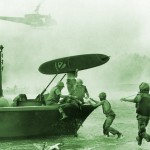
-
Colonel Kilgore’s board (Apocalpyse Now, 1979)
-
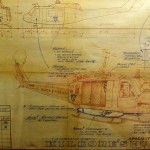
-
Kilgore’s chopper. Courtesy The Surfer’s Journal
To accompany our “Saigon Cowboy” in his endless summer safari, we are issuing a tiger stripe edition of the Board Shorts, a model we originally introduced for Spring 2014. These Mister Freedom® board shorts are inspired by several classic pairs of late 60’s~70’s trunks (Hang Ten, etc…), and feature an adjustable waist closure, Velcro® tape fly, side pocket, concealed rear pocket…
We scored some yardage of gold tiger stripe camouflage from our friends at Buzz Rickson’s. I believe this specific tiger pattern is referred to as TSP (Tadpole Sparse Pattern), but I’m probably wrong on that. The correct answer should be inside Richard Denis Johnson’s “Tiger Patterns” (ISBN 0-7643-0756-8).
For the salty look, we ‘partied-up’ our board shorts in two options, each featuring a single patch:
a) Reproduction “Sorry About That” red arc patch, with a local hand-made look.
b) Original 1970’s New Old Stock “Peace sign” patch.
Those inclined to do so will find many other vintage patches out there to spice this up, or a seam ripper to remove them. The older type machine-made patches are soft and have a cotton gaze-like back. They look much better in my opinion than the modern, rigid, iron-on kind found everywhere. Many eBay dealers offer reproduction or original patches from the Vietnam era.
I personally opted for three patches on my trunks, to take on bust-a-twig patrol while doing the jungle cancan.
-
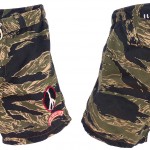
-
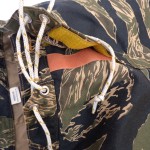
-
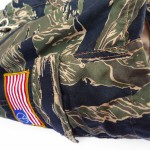
-
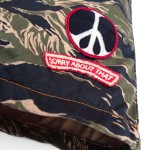
-

-
bust-a-twig patrol
-
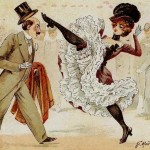
-
lala lalalalala la…
The Tiger Board Shorts are designed and manufactured in California by Mister Freedom®, in collaboration with Sugar Cane Co.
SPECS
FABRIC:
Buzz Rickson’s 100% cotton twill, printed with TSP (Tadpole Sparse Pattern) gold tiger stripe camouflage. Made in Japan.
DETAILS:
* Late 60’s to 1970’s style
* Paracord/eyelet waist closure system.
* Velcro® fly closure.
* Reproduction or NOS patch customization.
* Side pocket with Velcro® closure flap.
* Rear concealed sand pocket.
* Orange poly-cotton contrast stitching.
* Made in USA.
SIZING/FIT
The board shorts are only available RAW.
The tiger board shorts will shrink to tagged size. The way the waistband closure is designed allows for a 1-1½ inch play, according to how tightly pulled the paracord is.
Please refer to sizing chart for soak/line dry measurements (please note that further shrinkage can be expected with hot soak and machine dry.)
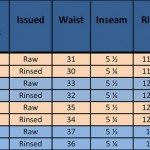
CARE:
Low maintenance, machine wash when needed. Color fading to be expected overtime.
Available Raw (unwashed) ONLY
Tagged Sizes
X-SMALL (approx W28)
SMALL (approx W30)
MEDIUM (approx W32)
LARGE (approx W34)
XLARGE (approx W36)
Retail $149.95
Available from www.misterfreedom.com, fine retailers around the World, and our dusty Los Angeles brick & mortar store.
Email sales@misterfreedom.com or call 323-653-2014 with any questions unanswered above.
Thank you for your support.
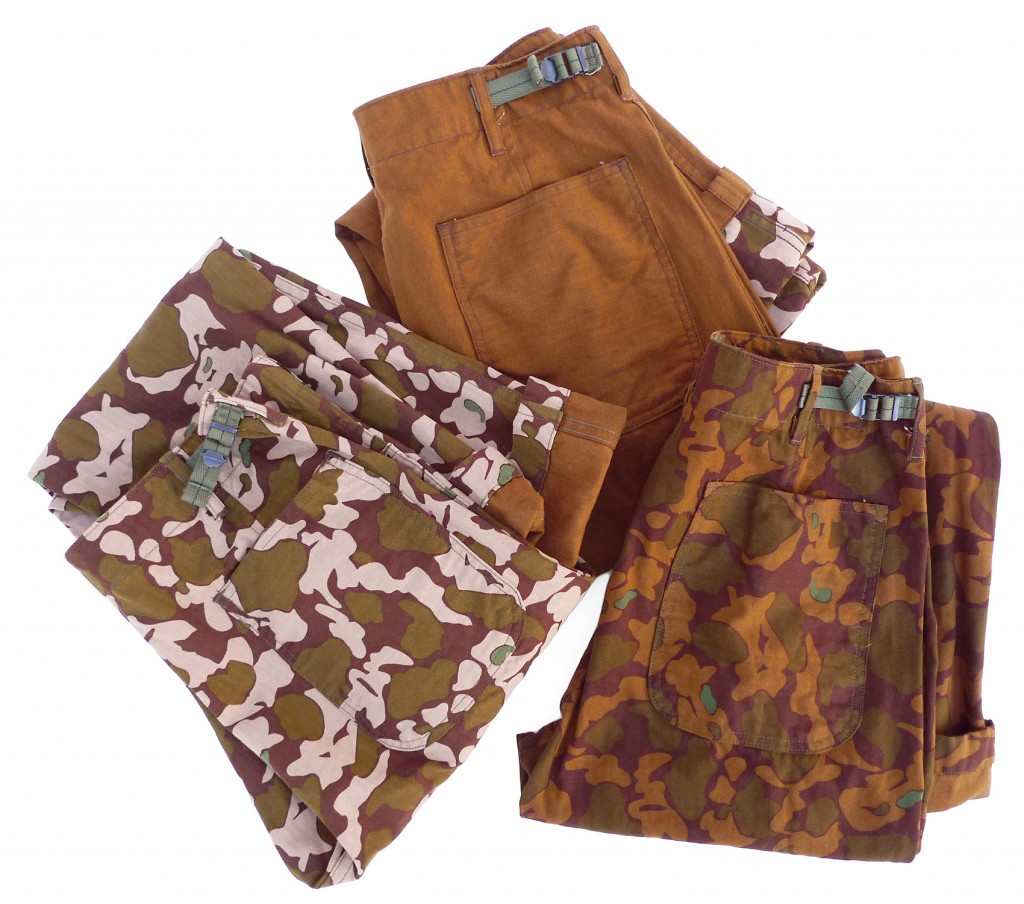
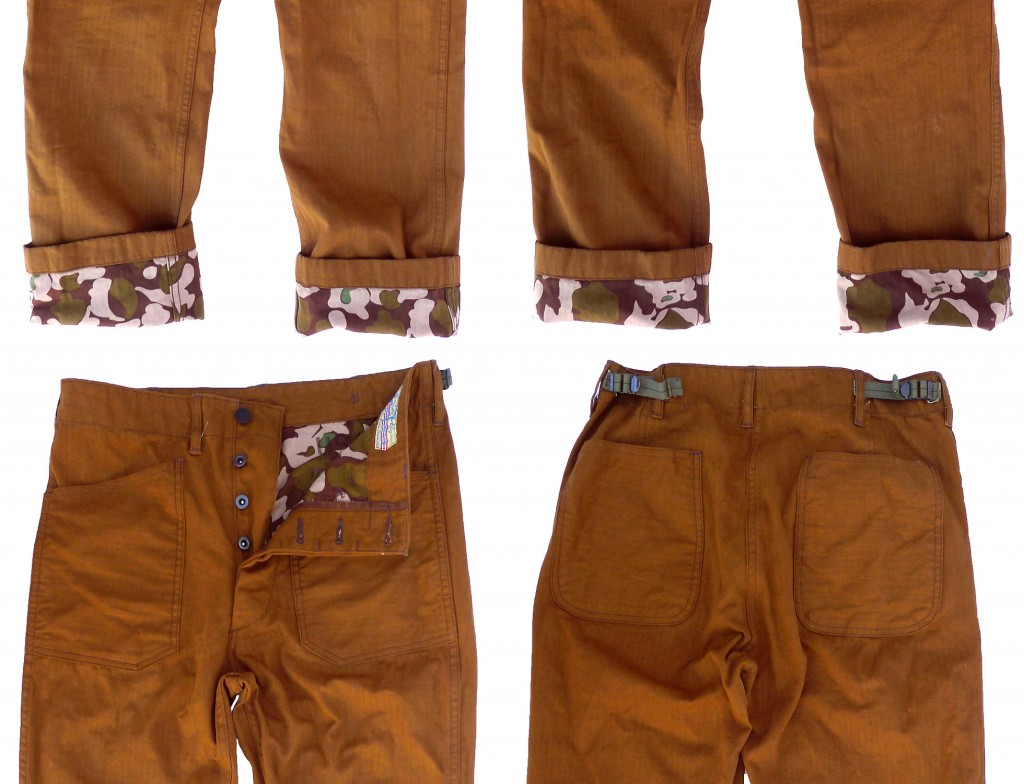 Utes Cachou.
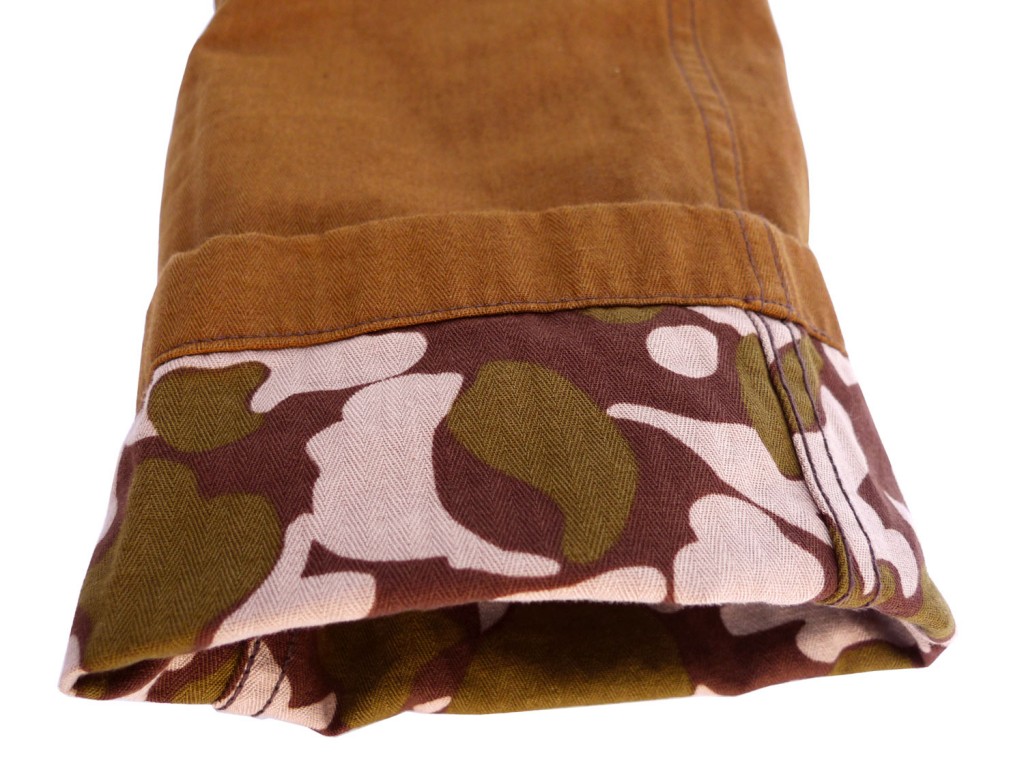
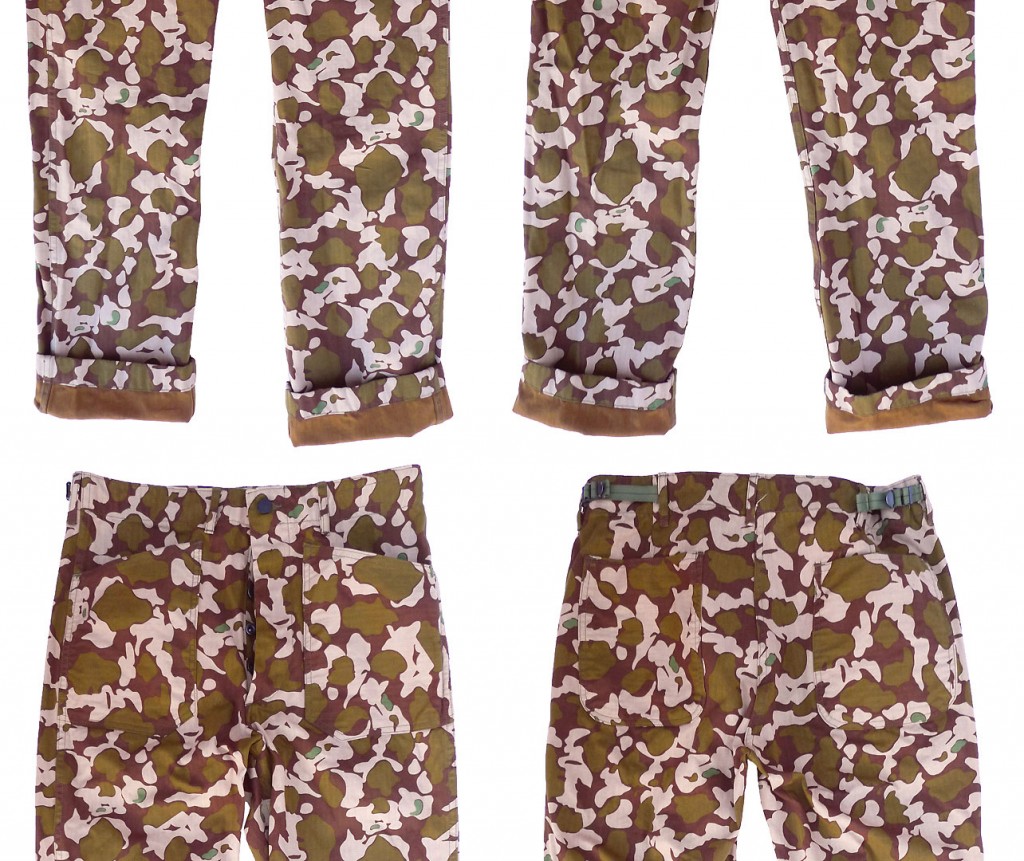 Utes Hiland.

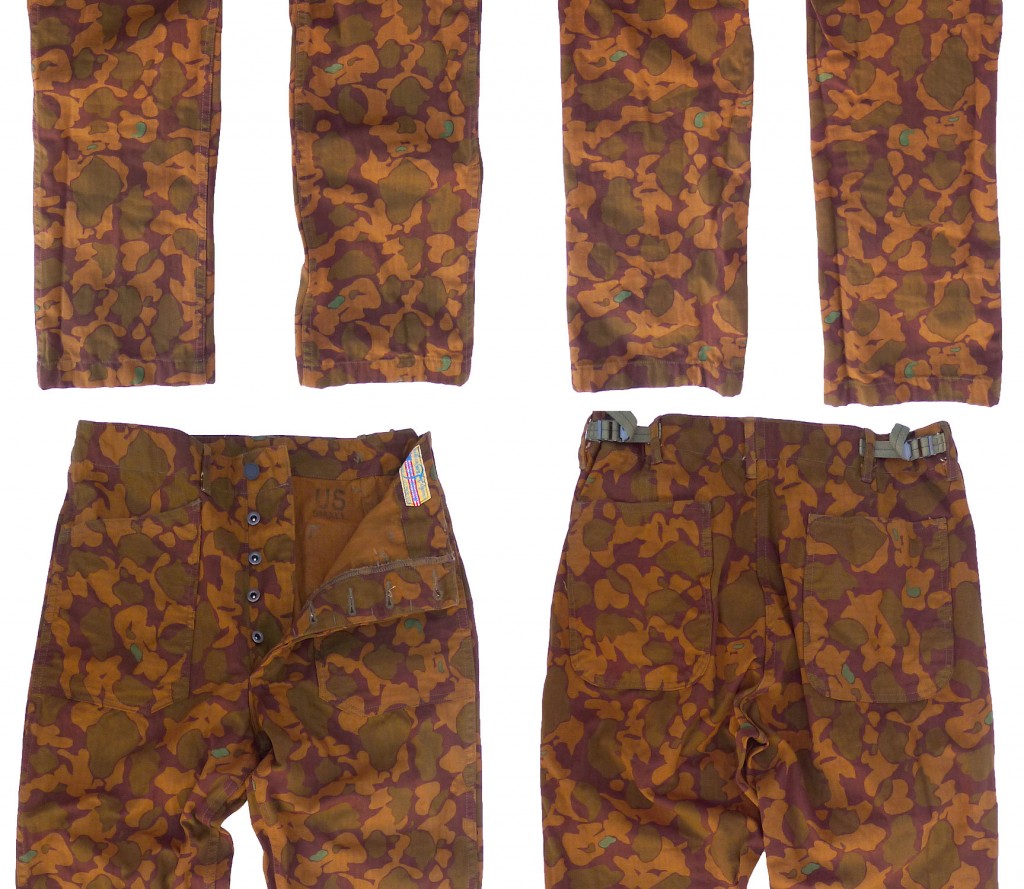 Utes Loland.
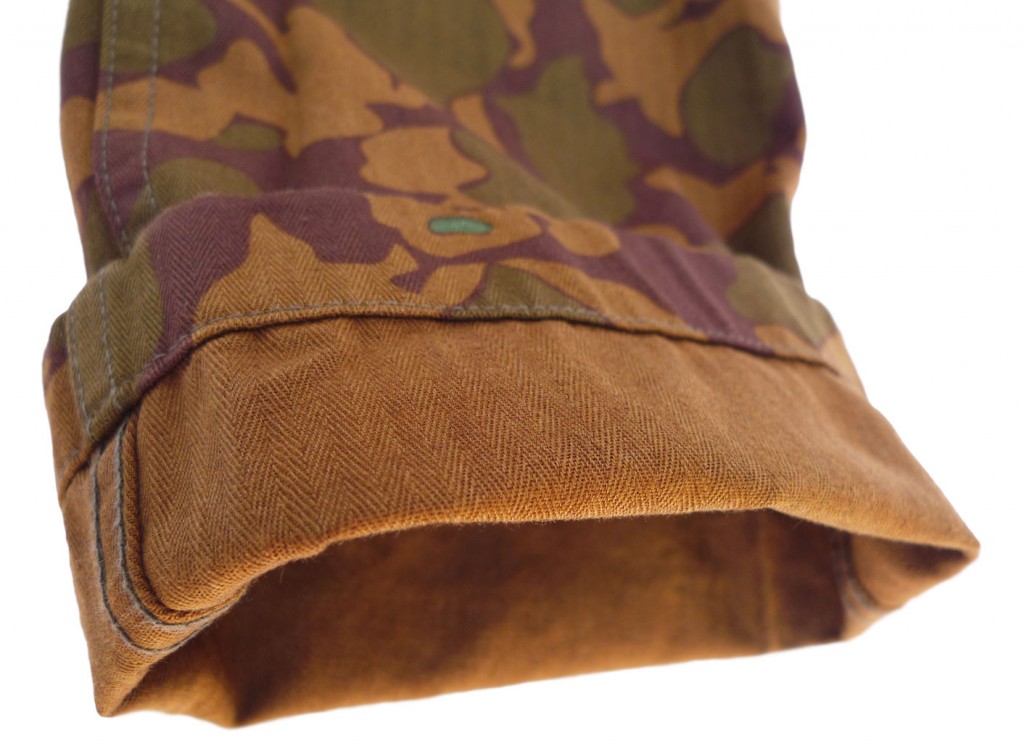
Utility Trousers, “Utes” Experimental Camouflage
Mister Freedom® “Saigon Cowboy” Spring 2015
For those into the jungle tuxedo, our MF® Experimental Camo is now available in fine looking trousers as well! For those lucky to have missed it, the account of how our original camouflage pattern came to be was summed up in the Evac Jak spiel.
For today’s story, who needs fiction when you have CIA declassified intel? Here is some of it, revisited…
The year is 1961.
American taxpayers have been unknowingly forking over $400 million to the French imperialist war effort in Indochina from 1945 to 1954 (thereby funding about 80% of the French Guerre d’Indochine), but we are still four years short of the ‘official’ engagement of the United States in Vietnam’s affairs of 1965.
In those years, some felt that if you didn’t stop the red devils (‘commies’) in the jungles of South East Asia, “they would have to be stopped in Honolulu or on the beaches of California.”
President Kennedy, a man of his times and a believer in the efficiency of US Special Forces guerilla tactics, sends 400 tiger stripes-clad intensively trained men to the highlands of South Vietnam in May 1961, in an effort to contain the spread of the National Liberation Front (NLF), China’s protégé…
Men in green berets immerse in the local culture, assess the situation and organize local resistance. Montagnards and local villagers receive training in jungle warfare. The enemy du jour? The Việt Cộng (Vietnamese Communists) guerrillas, VC (NATO’s Victor Charlie), or Charlie as often referred to by US boots on the ground.
A program called CIDG (Civilian Irregular Defense Group) and originally designed by the CIA has the task to assist in the transformation of local minorities into anti-communist paramilitary forces.
To more efficiently handle logistics, the highly-classified Counter Insurgency Support Office is established on the island of Okinawa, Japan in 1963. Headed by a mysterious individual working for the Department of Army by the name of Conrad Benjamin Baker, CISO was “assigned the mission of supporting the Special Forces programs through triservice depots and local procurement sources (…) Many items of clothing and equipment, for example, had to be obtained from markets in other countries because of size problems, composition of material, and equipment which had to be tailored to Montagnard measurements.” (source)
CISO acquired or produced ‘sterile’ (untraceable if captured) weapons, along with unmarked clothing and equipment to outfit US Special Forces or advisors heading out to South Vietnam. Locally screen-printed tiger stripe camo fatigues, “bowie” knives, VC-style black pajamas, rations, machetes, Seiko watches for recon teams, black 1-0 rain jackets, North Vietnamese Army-inspired rucksacks…
Basically, if it proved needed in the field, CISO sourced it out in Asia, or designed it and manufactured it locally. At a fraction of the price compared to US-made mil-specs issued gear, and quicker delivery than its state-side bureaucracy-laden official channel alternative. What exactly went on is not well documented, but Ben Baker’s account of his involvement in the original design and R&D of the famous SOG knife is available for download in pdf form here.
Note:
I am no expert on the topic and more accurate facts are available to those interested in History preservation willing to do the research. The “SOG” book by John L. Plaster probably answers many questions, but I admit having only flipped through its photo album companion (ISBN 1-58160-058-5) due to time restriction.
-
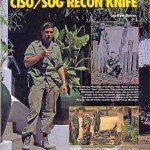
-
Courtesy of “Fighting Knives” magazine (1991)
-

-
1-0 CISO Jacket (Courtesy Jim Brzozkiewicz)
-

-
3rd Force Recon Patrol (Courtesy Doc Cassidy)
-
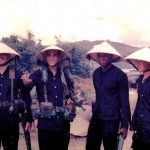
-
LRRPS (Photo Albert R. Brown 1968) Courtesy www.lrrpranger.org/
-

-
Montagnard in training (1962)
-
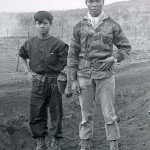
-
Montagnard Civilian Irregular Defense Group force attached to Company D MIKE-FORCE in the Dak To SF Camp fire-base
-
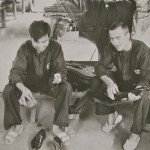
-
Special Forces Lt. Rich Entlich (1966) Courtesy Charlotte Sun newspaper
-
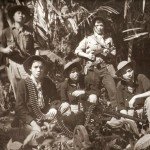
-
VC Guerrillas South Vietnam (1968)
-
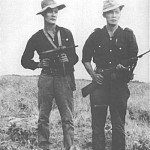
-
The feared “Men in black pajamas” (NVA photo 1968)
(Above photos credited to the best of our knowledge and provided for educational purposes only.)
I had found the logistics side of this CISO story quite fascinating when originally coming across it. As usual, we didn’t take any of this literally in our ‘Saigon Cowboy‘ venture. Imagination took over authenticity. We didn’t go black pajamas, decided to improvise instead, mixing things up into a somewhat plausible garment. Or maybe our ‘utes’ are just a pretext for sharing a slice of ‘behind-the-scene’ History…
The pattern for the featured MF® trousers this season blends details of US Navy dungarees, Army chino trousers, M-51 field trousers, Marine Corps M1941 trousers… a joint operation if you will.
The term ‘utes’ was lifted from the old USMC expression “boots ‘n’ utes” (boots and utility uniform).
As mentioned with the Evac Jak, the MF® Exp. camo combines camouflage with a simple solid side. The solid side cachou color is a reference to the caramel-like color typical of 1930’s French military canvas gear. Although this fabric is designed to be reversible, the trousers are not. Three options are available for the Exp camo utilities:
a) Cachou out/HiLand in.
b) HiLand out (arid terrain, lighter)/cachou in.
c) LoLand out (jungle, darker)/cachou in.
The sizing S,M,L,XL applied to trousers is a nod to old military field pants featuring cinch tabs. Those are often tagged with a ‘size range’ as opposed to a precise measurement, reflecting the waist-adjusting pull tabs.
The “US” stamp stands for sizing following American standards, as opposed to the “A” stamp differentiating Asian standards garments with CISO-issued gear.
Our ‘utes’ have a slimmer silhouette than typical standard-issue cargo pocket camo utilities, a reference to a silhouette favored by ARVN troops of the period.
The “Utes” are designed in California by Mister Freedom® and manufactured in Japan by Sugar Cane Co.
SPECS
FABRIC:
Somewhat of an original Mister Freedom® camo pattern, double-side rotary screen printed (one side solid, one side camo), white 100% cotton Herringbone Twill (HBT) fabric base.
Fabric milled and printed in Japan.
DETAILS:
* Inspired by vintage military utility trousers.
* Slimmer ‘ARVN’-type silhouette.
* Mid-high waisted.
* Front patch pockets locked in side seam, rear patch pockets, horizontal HBT.
* Side cinch tabs, mil-spec slide buckle.
* Flat black-painted Metal “13 Stars” tack waist button.
* Oxidized black donut-type fly buttons.
* Flat felled seams, chainstitch.
* 100% cotton tonal stitching.
* Made in Japan.
SIZING/FIT
This garment comes raw/unwashed and will shrink to tagged size after an original cold soak/line dry. Further shrinkage to be expected with the use of hot water and heat dryer.
All three MF® Exp. Camo fabric options will shrink the same.
I decided to size down in those, as I had done with the Crew Pants of the Sea Hunt spring 2013 collection, and I am wearing a Small (30). When both fully cinched, the waist tabs can tighten the fit by about 2 inches, but a Medium looked too baggy on me. A tagged Small technically corresponds to a 30-32 inch waist.
Please refer to sizing chart for measurements reflecting a 30mn cold soak no agitation/light machine dry.
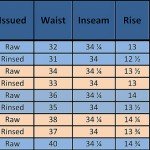
CARE:
Launder when hygiene dictates and common sense prevails.
Machine wash. Cold water, gentle cycle, eco-friendly mild detergent and line dry. We recommend turning garments inside out to avoid marbling of the fabric during the washing cycles.
Because the base HBT fabric is white before being printed, toning down of colors will naturally occur. This fading should not be considered a quest nor a defect, only the natural consequence of the wash/wear process over the years.
Available RAW/unwashed
SIZES:
Small (30)
Medium (32)
Large (34)
X-Large (36)
XX-Large (38)
RETAIL $229.95
Available from www.misterfreedom.com, fine retailers around the World, and our dusty Los Angeles brick & mortar store.
Email sales@misterfreedom.com or call 323-653-2014 with any questions unanswered above.
Thank you for your support

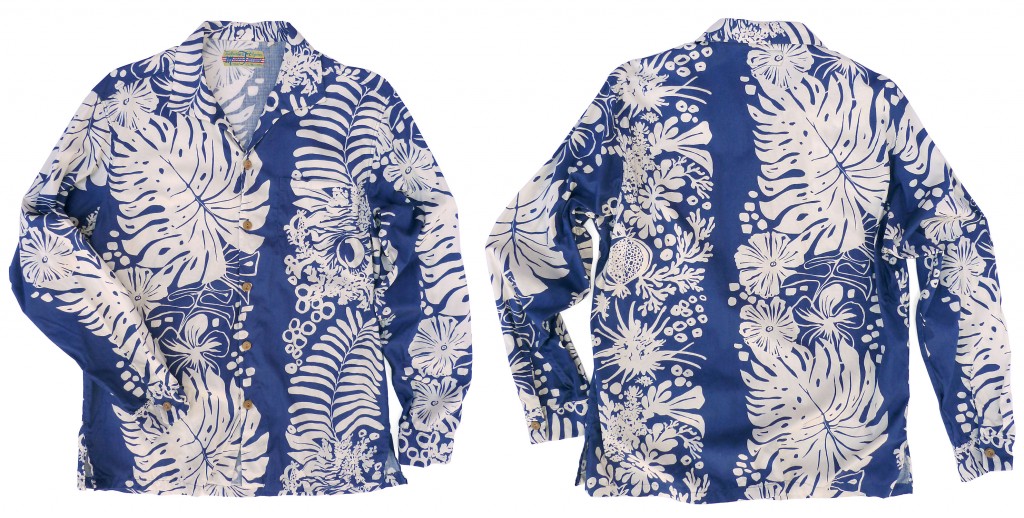
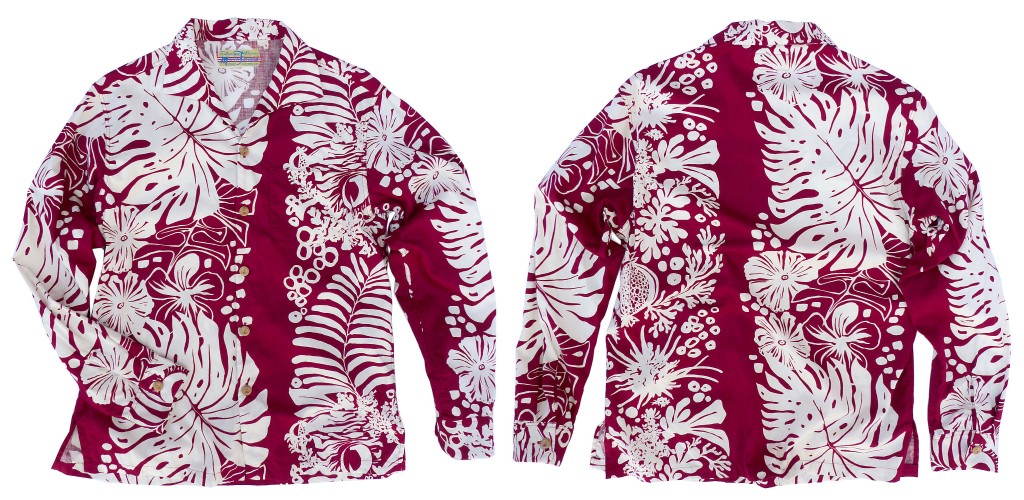
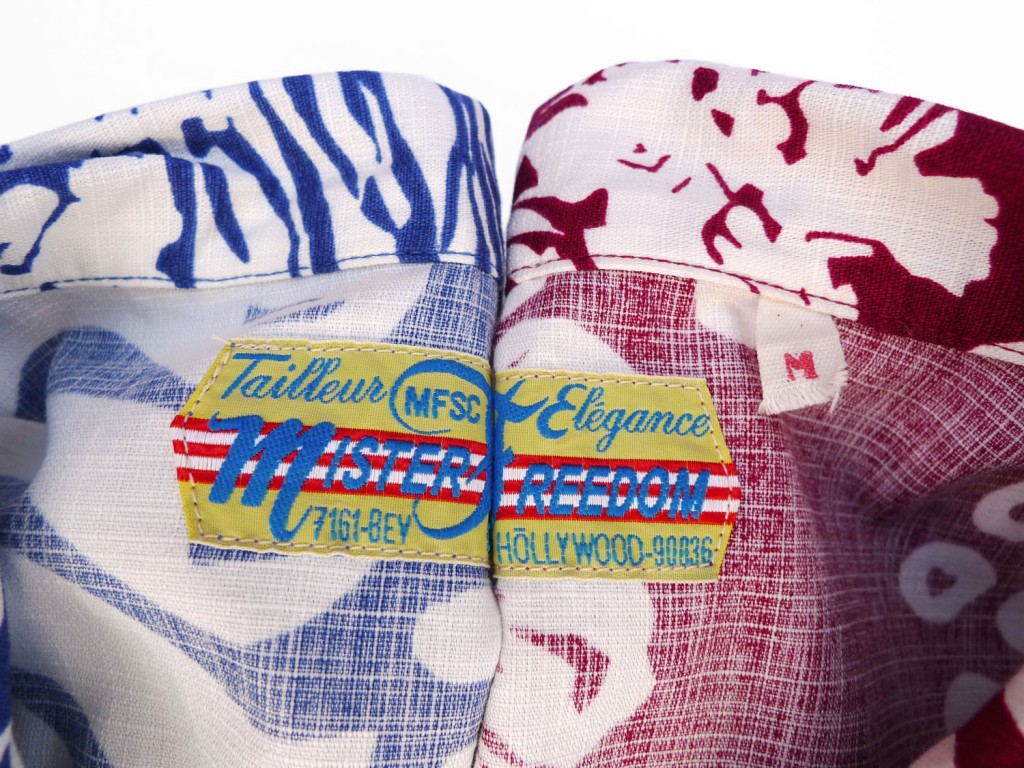
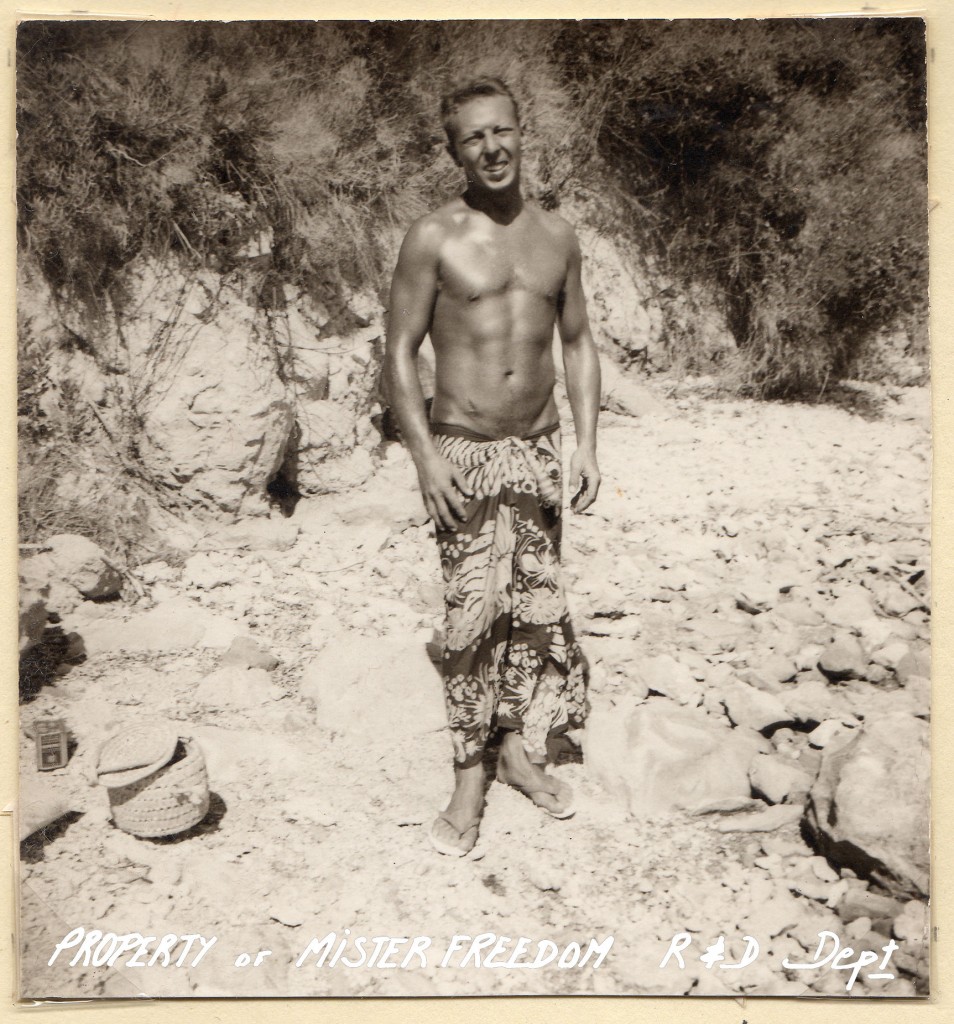 Who needs a shirt
-
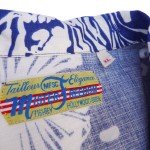
-
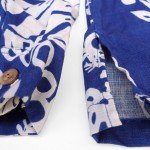
-
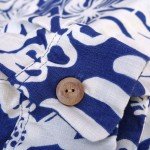
-
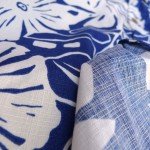
-
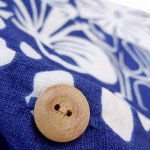
-
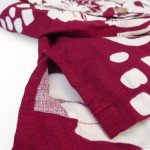
-

-
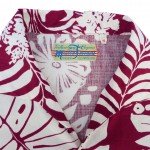
-
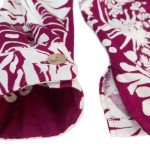
-
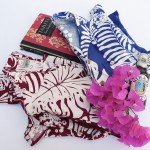
-
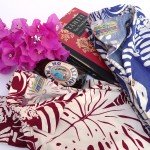
-
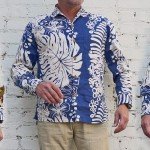
-
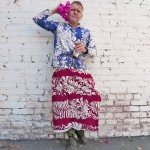
-
Celebrating Spring 2015
-

-
Drop the joystick and read a book
The “TAHITI” Shirt
“Saigon Cowboy” mfsc Spring 2015 Collection.
The short tale of this Mister Freedom® “Tahiti Shirt” involves the Club Med village of a sun-drenched Greek island in the late 1950’s, and a young adventurer half my age.
In the Club Méditerranée tradition of their early beach-front vacation villages, GOs (Gentils Organisateurs, the nice staff) were often issued printed pareos, in order to stand out and better entertain the GM (Gentils Membres, the nice vacationers). Nothing spells fun-in-the-sun like Polynesian prints do. For the French, Tahiti is the ultimate exotic-sounding escape from the daily grind, known as metro/boulot/dodo (commute/work/sleep) by the Parisians. For baguette lovers, anything associated with Tahiti means H.O.L.I.D.A.Y.S (no, not Johnny), save for the nuclear mushrooms of Mururoa, maybe.
-
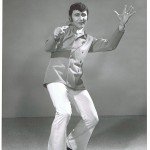
-
Johnny HOLIDAY, USA
-
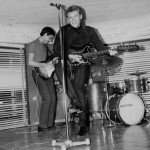
-
Johnny HALLYDAY, France
-
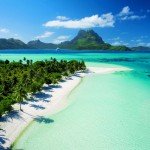
-
Bora Bora, anyone?
-

-
Baguette lover in Bora Bora (1995)
-
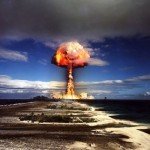
-
780 miles from Tahiti, Mururoa Atoll nuclear testing (1970)
In some villages, these Tahiti-style colorful cloth wraps were cut & sewn into aloha tops by local tailors or whoever handled the sewing machine best. I own two of these vintage shirts, had them for years. Mine originally belonged to a young fellow who had done a short stint as a GO in Greece, sometime in 1957. For just a few months, but long enough to improve on his water ski and social skills, and shake the djebel dust and smell of war off his mind.
The year prior, he had been enjoying twelve months of bushwhacking in green fatigues in the arid Algerian mountains. Military service was mandatory in France in 1956, and if you had just missed ‘l’Indo‘, you were about ripe for ‘l’Algérie‘.
A French colony since 1830, Algeria had been at war with France since 1954, claiming back its autonomy. For Algerian nationalists who had closely watched the demise of the old French colonial powers in Indochina culminating in the Diem Bien Phu firework finale, independence didn’t seem like utopia anymore. If their Vietnamese comrades had done it, so could they. But generations of French Algeria-born Pieds-Noirs, harkis, …, and a coalition of rogue generals, were not giving up that easy. Ensued the epic and gruesome Guerre d’Algérie (1954-1962), a very touchy topic to this day between both countries. Just quote Charles De Gaulle’s “Je vous ai compris” (I understood you) to a Pied-Noir, and watch what happens… For one planning to vacation in Algiers over the holidays, mentioning the OAS while strolling in the Casbah will also prove a great ice breaker to meet friendly locals.
But like they say, one front at a time, we’ll get back to this one some other day…
After getting his diploma in paréo-ironing from the Greeks, our playboy waterski instructor made his way back to Algeria in the following years. This time roaming the mighty Sahara desert as a drilling scout for the CPA (Compagnie des Pétroles d’Algérie, an oil extracting venture in North Africa). While at it, he managed to give a pretty Pied-noir gal his GO shirt, and my Mum a new last name…
None of the green fatigues, but two of the Club Med “Tahiti” shirts along with old photo albums happened to survive my Dad’s tumultuous expat life. He had nothing but contempt for hoarding, a ‘give-it-all-away’ modus operandi not shared by my Mum who often resulted to hiding things in order to find then again! I have an inclination to not collect anything myself, but I admit the few old relics he did not succeed in getting rid of back then are priceless to me today. Gérard Loiron, you are missed.
-
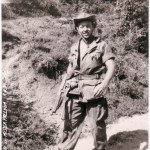
-

-

-
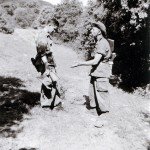
-
Kindly making a suggestion
-
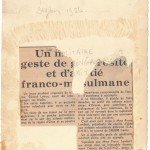
-
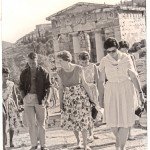
-
Ladies, please
-
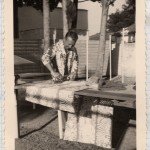
-
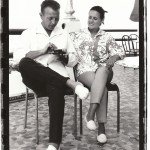
-
The Loiron’s
-

-
Original 1950’s Club Med shirts
-
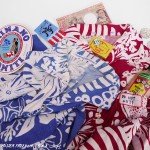
-
Discreet product placement
Both shirts were sent to our Sugar Cane Co friends in Japan and the fabric and prints analyzed. Hats off to the Toyo textile experts who reconstituted the entire panel artwork without taking the vintage samples apart. The floral design is non-symmetrical, as can be seen on the paréo-ironing session photo, and the motif repeat was very difficult to recreate for the Sun Surf® Graphic Dept. But it seems there is nothing they can’t do when it comes to Aloha-type shirts. Otsukaresama deshita.
The base textile of our Tahiti shirt is reminiscent, in texture, of those vintage kitschy 1960’s/70’s cotton Hawaiian shirts sometimes referred to as ‘bark cloth’. In the 1940’s/50’s, a thick and heavy version of that dobby weave cotton cloth had become a standard feature in most American households, in the form of printed curtains and upholstery fabric.
All those vintage iterations were modern renditions of the ancient Hawaiian kapa (or tapa in Tahitian, meaning ‘the beaten thing’), the natural wood pulp bark cloth of early traditional Polynesian attire that so impressed Captain James Cook back in 1769. “This stuff is awesome! Where to cop?” he reportedly said on his final voyage to the Pacific Islands, before being clubbed on the beach. But you might want to double-check on that.
Our “Tahiti Shirt” in barkcloth-like cotton fabric comes in two color options, coined by the MF® Linguistic Dept as Moana (meaning the mighty Ocean ie. the Big Blue) and Ura (meaning red), for the sole purpose of qualifying you as the most fluent individual in Tahitian language of your neighborhood at this second.
-
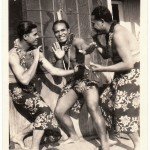
-
Doing the hula bop in pareo
-
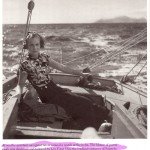
-
Pareo blouse by Lin Fung Chu, leading couturier of Papeete (1953)
-
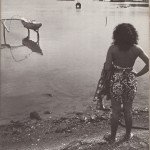
-
Tahiti ‘Voyage Through Paradise’ George T. Eggleston (1953)
At this point, a quite pertinent remark would be “how you planning to landfall that canoe in Saigon, son?“, in other words “The Nam?! Fun in the sun??!? wtf?!?!”
That’s when R&R comes in. No, not the devil’s music, I mean Rest & Recreation.
During their 12 or 13-month Vietnam tour, American soldiers could take a one-time leave out of Vietnam, for a maximum of 30 days. Jungle fatigues were dropped at the departure air base, khakis slipped on, and civvy clothing often rented at the destination. Popular escapes were Hawaii, Sydney, Bangkok, Hong Kong… from where souvenirs and loads of crusty epic stories were brought back.
Additionally, shorter in-country R&R were awarded to wary grunts with an urgent need to go cool off away from Agent Orange and Victor Charlie for a few days. The South China Sea waters of Cam Ranh Bay, Vung Tau, and the famed Da Nang China Beach saw many a sunburnt GIs come and go during the 10 years of the Vietnam war. Some days, those beaches almost looked like beaches at home, save for the M-16 of the US Marine lifeguard on tower duty, or the occasional bandages from hospital ships washing ashore. Sorry ’bout that.
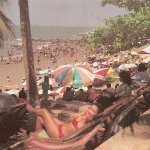 Vung Tau Beach R&R (1966) Cinephiles will also notice that the Mister Freedom® “Tahiti shirt” is a nod to the famous M*A*S*H* war comedy film and TV series, which featured characters (“Trapper John” or “Hawkeye”) flashing a floral shirt in the context of a Mobile Army Surgical Hospital. A wardrobe oxymoron, intended to highlights the level of gallows humor necessary in the field to help deal with the absurdity and brutality of war.
“... it was so far out, you couldn’t blame anybody for believing anything. Guys dressed up in batman fetishes, I saw a whole squad like that, it gave them a kind of dumb esprit. Guys stuck the ace of spades in their helmet bands, they picked relics off of an enemy they’d killed, a little transfer of power; they carried around five pound bibles from home, crosses, St. Christophers, Mezuzahs, locks of hair, girlfriends’ underwear, snaps of their families, their wives, their dogs, their cows, their cars, pictures of John Kennedy, Lyndon Johnson, Martin Luther King, Huey Newton, the Pope, Che Guevara, The Beatles, Jimi Hendrix, wiggier than cargo cultists.”
(Excerpt from Michael Herr’s ‘Dispatches‘, correspondent for Esquire Magazine in Vietnam, 1967-1969.)
Anyways, the “Tahiti shirt” was designed in California by Mister Freedom® and manufactured in Japan in collaboration with Sugar Cane Co.
SPECS:
FABRIC:
100% cotton ‘bark cloth’ like dobby fabric base. 1950’s Polynesian floral design print replica. Fabric milled in Japan.
DETAILS:
* Original mfsc updated pattern, inspired by authentic 1950’s local-made tourist attire.
* Long sleeve.
* French style col requin (shark fin shape collar)
* Genuine coconut shell buttons.
* Matching single chest pocket.
* No back yoke.
* Side slits.
* Flat-felled seam chainstitch construction, narrow folder.
* High count 100% cotton tonal stitching.
* Limited edition.
* Made in Japan.
SIZING/FIT
The “Tahiti” shirt comes raw/unwashed and will shrink to tagged size after an original cold soak/line dry.
If you are a Medium in mfsc shirting, you are a Medium in this shirt.
We recommend an initial cold soak, spin dry and line dry. Please refer to sizing chart for measurements reflecting this method.
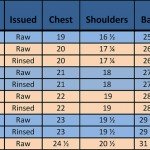
CARE:
Launder when hygiene dictates and common sense prevails.
Machine wash. Cold water, gentle cycle, eco-friendly mild detergent and line dry.
Available RAW/unwashed.
SIZES:
Small
Medium
Large
X-Large
XX-Large
RETAIL $269.95
Soon available from www.misterfreedom.com
Email sales@misterfreedom.com or call 323-653-2014 with any questions unanswered above.
Maururu for your support 🙂
|



